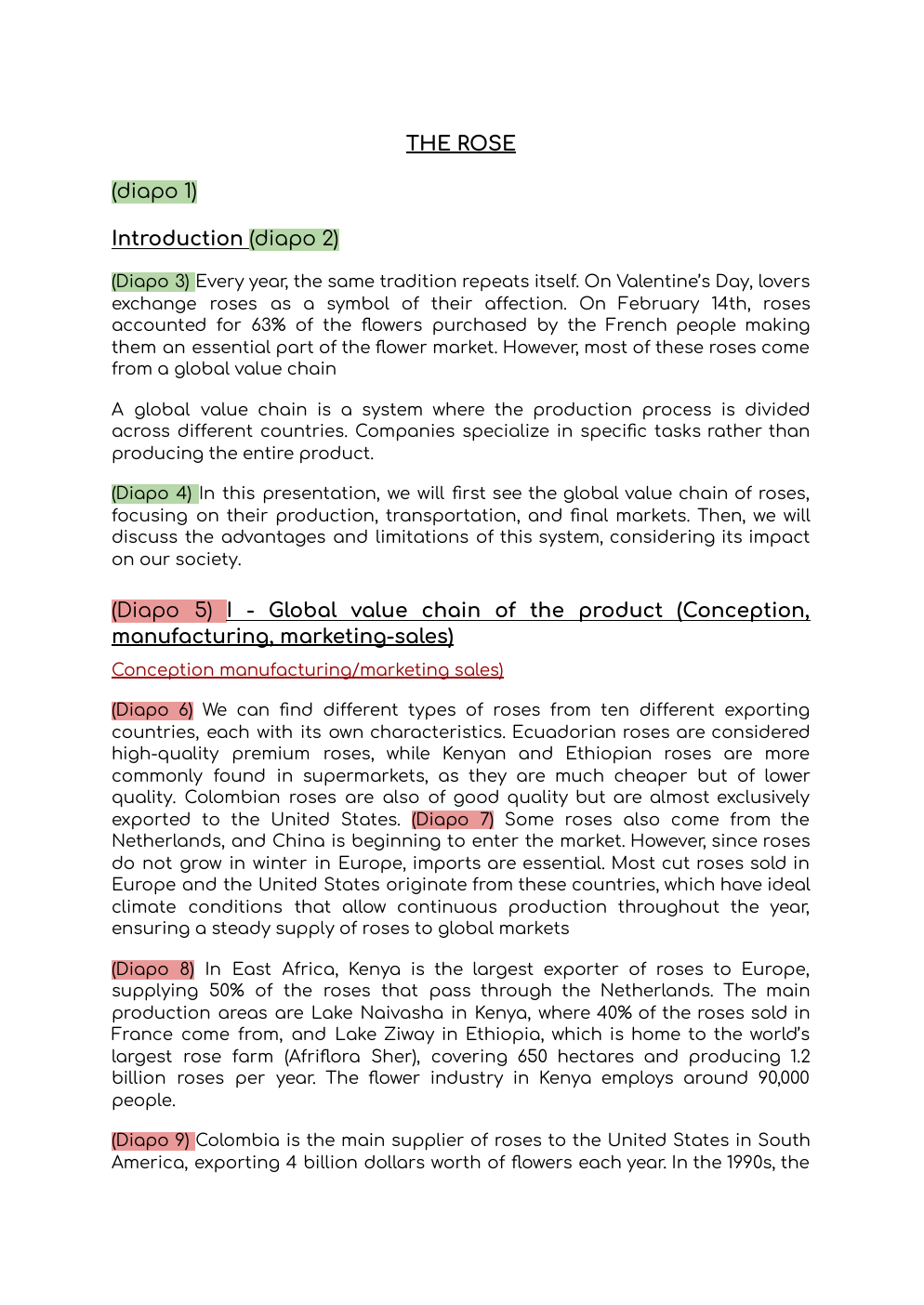Global chain : Roses
Publié le 23/02/2025
Extrait du document
«
THE ROSE
(diapo 1)
Introduction (diapo 2)
(Diapo 3) Every year, the same tradition repeats itself.
On Valentine’s Day, lovers
exchange roses as a symbol of their affection.
On February 14th, roses
accounted for 63% of the flowers purchased by the French people making
them an essential part of the flower market.
However, most of these roses come
from a global value chain
A global value chain is a system where the production process is divided
across different countries.
Companies specialize in specific tasks rather than
producing the entire product.
(Diapo 4) In this presentation, we will first see the global value chain of roses,
focusing on their production, transportation, and final markets.
Then, we will
discuss the advantages and limitations of this system, considering its impact
on our society.
(Diapo 5) I - Global value chain of the product (Conception,
manufacturing, marketing-sales)
Conception manufacturing/marketing sales)
(Diapo 6) We can find different types of roses from ten different exporting
countries, each with its own characteristics.
Ecuadorian roses are considered
high-quality premium roses, while Kenyan and Ethiopian roses are more
commonly found in supermarkets, as they are much cheaper but of lower
quality.
Colombian roses are also of good quality but are almost exclusively
exported to the United States.
(Diapo 7) Some roses also come from the
Netherlands, and China is beginning to enter the market.
However, since roses
do not grow in winter in Europe, imports are essential.
Most cut roses sold in
Europe and the United States originate from these countries, which have ideal
climate conditions that allow continuous production throughout the year,
ensuring a steady supply of roses to global markets
(Diapo 8) In East Africa, Kenya is the largest exporter of roses to Europe,
supplying 50% of the roses that pass through the Netherlands.
The main
production areas are Lake Naivasha in Kenya, where 40% of the roses sold in
France come from, and Lake Ziway in Ethiopia, which is home to the world’s
largest rose farm (Afriflora Sher), covering 650 hectares and producing 1.2
billion roses per year.
The flower industry in Kenya employs around 90,000
people.
(Diapo 9) Colombia is the main supplier of roses to the United States in South
America, exporting 4 billion dollars worth of flowers each year.
In the 1990s, the
U.S.
government supported the Colombian rose industry to reduce drug
trafficking, which led to a 95% drop in U.S.
rose production between 2009 and
2015.
In Ecuador, rose growers earn about $400 per month, while in Kenya, they
earn only €100 per month.
(Diapo 10) The transportation and distribution of roses are highly efficient to
maintain their freshness.
After 15 weeks of growth, the roses are cut, cooled to
4°C, and transported in refrigerated trucks.
Most roses are then shipped by
cargo planes.
Before Valentine’s Day, 5 to 6 planes leave Kenya every night,
each carrying up to 120 tons of flowers to Amsterdam.
In the United States, 30
daily flights transport 15,000 tons of roses from Colombia to Miami in the three
weeks before Valentine's Day.
The Netherlands plays a central role in the global flower trade.
The Royal Flora
Holland market in Aalsmeer, also known as the “Wall Street of Flowers”, is the
largest flower auction in the world.
50% of the world’s flower trade passes
through Amsterdam, and from there, the roses are distributed across Europe,
mainly to Germany, the UK, and France.
(Diapo 11) The flower industry is a major global business, generating $34 billion
per year.
In France, people spend around €30 million on cut flowers for
Valentine’s Day, mostly on imported roses.
In Kenya, horticulture is the
third-largest industry after tea and tourism, generating $709 million in 2019.
(Diapo 12)II.
Advantages/ Limits
(Diapo 13) Avantages
(Economics)
(Diapo 14) This globalization comes with its good and bad side.
On the good....
»
↓↓↓ APERÇU DU DOCUMENT ↓↓↓
Liens utiles
- Sujets épreuve d'EURO pour le BAC, Lycée (Ocean Acidification, Global Warming, Jeans): Why is ocean acidification problematic ?
- New York, a global city
- Citizens assemblies and global warming (short essay)
- Reconstitution du climat global de la planète à la fin du Carbonifère (Permo-Carbonifère ou Carbo- Permien, -300Ma) et causes principales
- Géorgie (2003-2004 ): La «révolution des Roses»


